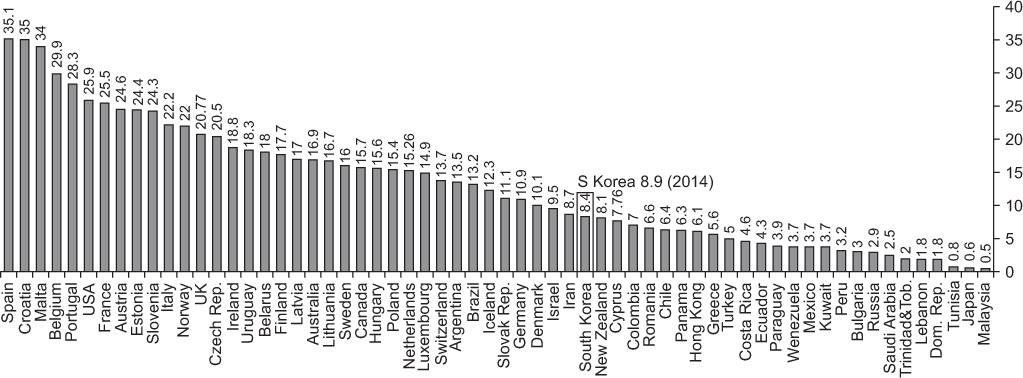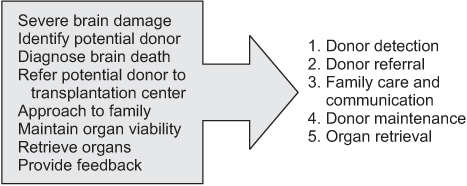Ewha Med J.
2015 Mar;38(1):1-6. 10.12771/emj.2015.38.1.1.
Activation Policy for Brain-dead Organ Donation
- Affiliations
-
- 1Department of Anesthesiology and Pain, Ewha Womans University School of Medicine, Seoul, Korea. sicuab@hotmail.com
- KMID: 2171322
- DOI: http://doi.org/10.12771/emj.2015.38.1.1
Abstract
- Organ transplantation has become the standard of care for treatment of end stage organ failure patients medically suitable for transplantation. Unfortunately, the availability of transplantable organs has not been able to meet the high demand. The organ shortage of transplantation has become worldwide and a national crisis. Despite various attempts to expand the donor pool, the difference between organ supply and organ demand continues. This article reviews methods to increase the number of potential deceased organ donor and the number of organs per donor by aggressive donor management protocol.
MeSH Terms
Figure
Cited by 1 articles
-
A study on the performance of the Donation Improvement Program in Korea
Su Jin Heo, Yong Ho Ju, Eun Jeong Noh, Kyoung Min Kim, Yu Kyoung Son, Sun Woo Jung, Hyun Jin Kang, Jung Rim Lee, Won Hyun Cho, Jongwon Ha
Korean J Transplant. 2021;35(2):77-85. doi: 10.4285/kjt.21.0006.
Reference
-
1. Ministry of Health and Welfare. The laws of organs trans-plantation [Internet]. Seoul: Ministry of Health and Welfare;2010. cited 2015 Mar 5. Available from: http://www.law.go.kr/lsSc.do?menuId=0&p1=&subMenu=1&nwYn=1§ion=&query=The+laws+of+organs+trans-plantation+&x=41&y=11#liBgcolor0.2. Persson NH, Omnell Persson M, Ekberg H, Kallen R, Waldner A. Renal transplantation from marginal donors: results and allocation strategies. Transplant Proc. 2001; 33:3759–3761.3. Yu AS, Keeffe EB. Patient selection criteria for liver transplantation. Minerva Chir. 2003; 58:635–648.4. INTERNATIONAL REGISTRY in ORGAN DONATION and TRANSPLANTATION. IRODaT Newsletter 2013 [Internet]. Barcelona (SP): International Registry in Organ Donation and Transplantation;c2014. cited 2014 Dec. Available from: http://www.irodat.org/img/database/grafics/newsletter/IRODaT%20Newsletter%202013%20.pdf.5. Eurotransplant International Foundation. The yearly statistics of 2014 [Internet]. Leiden: Eurotransplant International Foundation;cited 2015 mar 5. Available from: https://www.eurotransplant.org/cms/index.php?page=yearlystats.6. Korean Network for Organ Sharing. Statistics of organ transplanstation [Internet]. Seoul: Korean Network for Organ Sharing;2014. cited 2015 Mar 5. Available from: http://konos.go.kr/konosis/sub4/sub04_03_01_pop.j.7. Alonso M, Fernandez M, Mataix R, Rincon MD, Corrales JA, Burgos R, et al. Donor action in Spain: a program to increase organ donation. Transplant Proc. 1999; 31:1084–1085.8. Wight C, Cohen B, Roels L, Miranda B. Donor action: a quality assurance program for intensive care units that increases organ donation. J Intensive Care Med. 2000; 15:104–114.9. Roels L, Wight C. Donor Action: an international initiative to alleviate organ shortage. Prog Transplant. 2001; 11:90–97.10. Roels L, Cohen B, Gachet C, Miranda BS. Joining efforts in tackling the organ shortage: the Donor Action experience. Clin Transpl. 2002; 111–120.11. The Donor Action Foundation. Donor Action Program [internet]. Leiden: DA Foundation;2009. cited 2015 Mar 5. Available from: http://www.donoraction.org.12. Lee SM, Lee YH, Kim SH, Kim SY. Study on perceptions and attitudes of Koreans on organ donation. J Korean Soc Transplant. 2003; 17:227–233.13. Kim MG, Jeong JC, Cho EJ, Huh KH, Yang J, Byeon NI, et al. Operational and regulatory system requirements for pursuing selfsufficiency in deceased donor organ transplantation program in Korea. J Korean Soc Transplant. 2010; 24:147–158.14. Mascia L, Mastromauro I, Viberti S, Vincenzi M, Zanello M. Management to optimize organ procurement in brain dead donors. Minerva Anestesiol. 2009; 75:125–133.15. Powner DJ, Darby JM, Kellum JA. Proposed treatment guidelines for donor care. Prog Transplant. 2004; 14:16–26. quiz 27-28.16. Wood KE, Coursin DB. Intensivists and organ donor management. Curr Opin Anaesthesiol. 2007; 20:97–99.17. Chavko R, Khan AS, Darby JM. Management of the brain-dead organ donor. In : Fink MP, Abraham E, Vincent JL, Kochanek PM, editors. Textbook of critical care. 5th ed. Philadelphia: Elsevier Saunder;2005. p. 2119–2129.18. Gelb AW, Robertson KM. Anaesthetic management of the brain dead for organ donation. Can J Anaesth. 1990; 37:806–812.19. Darby JM, Stein K, Grenvik A, Stuart SA. Approach to management of the heartbeating 'brain dead' organ donor. JAMA. 1989; 261:2222–2228.20. Bugge JF. Brain death and its implications for management of the potential organ donor. Acta Anaesthesiol Scand. 2009; 53:1239–1250.21. Wood KE, Becker BN, McCartney JG, D'Alessandro AM, Coursin DB. Care of the potential organ donor. N Engl J Med. 2004; 351:2730–2739.22. Slakey LM, Slakey CM, Slakey DP. Deceased donor management and demographic factors related to kidney allograft rejection and graft survival. Transplant Proc. 2010; 42:1513–1518.23. Dellinger RP, Levy MM, Rhodes A, Annane D, Gerlach H, Opal SM, et al. Surviving sepsis campaign: international guidelines for management of severe sepsis and septic shock: 2012. Crit Care Med. 2013; 41:580–637.24. Weiss S, Kotsch K, Francuski M, Reutzel-Selke A, Mantouvalou L, Klemz R, et al. Brain death activates donor organs and is associated with a worse I/R injury after liver transplantation. Am J Transplant. 2007; 7:1584–1593.25. United Network for Organ Sharing. Critical pathway for the organ donor [Internet]. Richmond, VA: United Network for Organ Sharing;cited 2015 Mar 5. Available from: http://store.unos.org/product.26. Wheeler AP, Bernard GR. Acute lung injury and the acute respiratory distress syndrome: a clinical review. Lancet. 2007; 369:1553–1564.27. Mascia L, Pasero D, Slutsky AS, et al. Effect of a lung protective strategy for organ donors on eligibility and availability of lungs for transplantation: a randomized controlled trial. JAMA. 2010; 304:2620–2627.28. Angel LF, Levine DJ, Restrepo MI, Johnson S, Sako E, Carpenter A, et al. Impact of a lung transplantation donor-management protocol on lung donation and recipient outcomes. Am J Respir Crit Care Med. 2006; 174:710–716.29. Pennefather SH, Bullock RE, Dark JH. The effect of fluid therapy on alveolar arterial oxygen gradient in brain-dead organ donors. Transplantation. 1993; 56:1418–1422.30. Totsuka E, Dodson F, Urakami A, Moras N, Ishii T, Lee MC, et al. Influence of high donor serum sodium levels on early postoperative graft function in human liver transplantation: effect of correction of donor hypernatremia. Liver Transpl Surg. 1999; 5:421–428.31. Pennefather SH, Bullock RE, Mantle D, Dark JH. Use of low dose arginine vasopressin to support brain-dead organ donors. Transplantation. 1995; 59:58–62.32. Marik PE. Techniques for assessment of intravascular volume in critically ill patients. J Intensive Care Med. 2009; 24:329–337.33. McKeown DW, Bonser RS, Kellum JA. Management of the heartbeating brain-dead organ donor. Br J Anaesth. 2012; 108:Suppl 1. i96–i107.34. Rosendale JD, Kauffman HM, McBride MA, Chabalewski FL, Zaroff JG, Garrity ER, et al. Aggressive pharmacologic donor management results in more transplanted organs. Transplantation. 2003; 75:482–487.35. Zaroff JG, Rosengard BR, Armstrong WF, Babcock WD, D'Alessandro A, Dec GW, et al. Consensus conference report: maximizing use of organs recovered from the cadaver donor: cardiac recommendations, March 28-29, 2001, Crystal City, Va. Circulation. 2002; 106:836–841.36. Rosendale JD, Kauffman HM, McBride MA, Chabalewski FL, Zaroff JG, Garrity ER, et al. Hormonal resuscitation yields more transplanted hearts, with improved early function. Transplantation. 2003; 75:1336–1341.37. Kellum JA, Venkataraman R, Powner D, Elder M, Hergenroeder G, Carter M. Feasibility study of cytokine removal by hemoadsorption in brain-dead humans. Crit Care Med. 2008; 36:268–272.38. Venkataraman R, Song M, Lynas R, Kellum JA. Hemoadsorption to improve organ recovery from brain-dead organ donors: a novel therapy for a novel indication? Blood Purif. 2004; 22:143–149.39. Dellinger RP, Levy MM, Carlet JM, Bion J, Parker MM, Jaeschke R, et al. Surviving Sepsis Campaign: international guidelines for management of severe sepsis and septic shock: 2008. Crit Care Med. 2008; 36:296–327.40. Belloma R, D'Intini V, Ronco C. Renal replacement therapy in the ICU. In : Fink MP, Abraham E, Vincent JL, Kochanek PM, editors. Textbook of critical care. 5th ed. Philadelphia: Elsevier Saunders;2005. p. 1151–1158.41. Lim SH, Lee YJ, Joe HB, Lee JM, Lee IK. Successful brain dead donor management with crrt: a case report. Korean J Crit Care Med. 2012; 27:286–289.
- Full Text Links
- Actions
-
Cited
- CITED
-
- Close
- Share
- Similar articles
-
- Management of brain-dead donors in Korea
- National Organ Transplantation Policy
- Recent Decrease in Organ Donation from Brain-Dead Potential Organ Donors in Korea and Possible Causes
- Study on Physician's Perceptions and Attitudes on Organ Donation in Brain Dead Donors
- Cases of inadequate donation in the operating room



